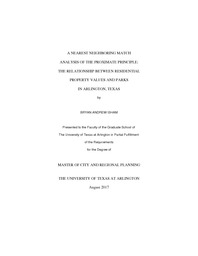
ATTENTION: The works hosted here are being migrated to a new repository that will consolidate resources, improve discoverability, and better show UTA's research impact on the global community. We will update authors as the migration progresses. Please see MavMatrix for more information.
Show simple item record
| dc.contributor.advisor | Li, Jianling | |
| dc.creator | Isham, Bryan | |
| dc.date.accessioned | 2017-10-02T14:29:37Z | |
| dc.date.available | 2017-10-02T14:29:37Z | |
| dc.date.created | 2017-08 | |
| dc.date.issued | 2017-08-11 | |
| dc.date.submitted | August 2017 | |
| dc.identifier.uri | http://hdl.handle.net/10106/26976 | |
| dc.description.abstract | Most studies of this type use a hedonic value method of analysis while using spatial analysis primarily as a tool in the analysis. The nearest neighboring match analysis used in this study uses spatial analysis as the primary method of measurement. Housing stock from Arlington, Texas from 2015 – 2016 is used to determine whether this type of analysis is effective in measuring the existence of the proximate principle. It proved difficult to obtain a large enough study group when attempting to include multiple different structural attributes. Ultimately, it was shown that a much larger timeframe may be needed in order to make the nearest neighboring match analysis method viable. | |
| dc.format.mimetype | application/pdf | |
| dc.language.iso | en_US | |
| dc.subject | Parks | |
| dc.subject | Residential property value | |
| dc.subject | Nearest neighboring match analysis | |
| dc.title | A NEAREST NEIGHBORING MATCH ANALYSIS OF THE PROXIMATE PRINCIPLE: THE RELATIONSHIP BETWEEN RESIDENTIAL PROPERTY VALUES AND PARKS IN ARLINGTON, TEXAS | |
| dc.type | Thesis | |
| dc.degree.department | City and Regional Planning | |
| dc.degree.name | Master of City and Regional Planning | |
| dc.date.updated | 2017-10-02T14:30:41Z | |
| thesis.degree.department | City and Regional Planning | |
| thesis.degree.grantor | The University of Texas at Arlington | |
| thesis.degree.level | Masters | |
| thesis.degree.name | Master of City and Regional Planning | |
| dc.type.material | text | |
| dc.creator.orcid | 0000-0002-3546-2470 | |
Files in this item
- Name:
- ISHAM-THESIS-2017.pdf
- Size:
- 5.800Mb
- Format:
- PDF
This item appears in the following Collection(s)
Show simple item record


